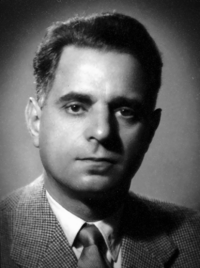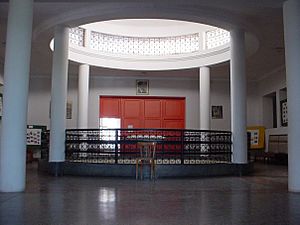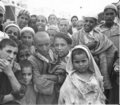Ahmed Balafrej facts for kids
Quick facts for kids
Ahmed Balafrej
|
|
|---|---|
|
أحمد بلافريج
|
|

Ahmed Balafrej in 1950
|
|
| Representative to Hassan II and Minister of Foreign Affairs | |
| In office 5 January 1963 – 13 November 1963 |
|
| Monarch | Hassan II |
| Preceded by | under the authority of Hassan II |
| Succeeded by | Ahmed Reda Guedira (as Minister of Foreign Affairs) |
| President of the Governing Council of Morocco and Minister of Foreign Affairs | |
| In office 12 May 1958 – 13 December 1958 |
|
| Monarch | Mohammed V |
| Preceded by | Mbarek Bekkay (as prime minister) |
| Succeeded by | Abdallah Ibrahim |
| Minister of Foreign Affairs | |
| In office 28 October 1956 – 16 April 1958 |
|
| Prime Minister | Mbarek Bekkay |
| Preceded by | office established |
| Personal details | |
| Born | 5 September 1908 Rabat, Morocco |
| Died | 14 April 1990 (aged 81) Rabat, Morocco |
| Political party | Istiqlal |
Ahmed Balafrej (Arabic: أحمد بلافريج) was an important leader in Morocco. He was born in Rabat on September 5, 1908, and passed away there on April 14, 1990. He served as the Prime Minister of Morocco for a short time in 1958. Balafrej played a huge role in helping Morocco gain its independence from colonial rule.
Contents
Early Life and Education
Ahmed Balafrej was born in 1908 into a well-known family in Rabat, Morocco. His family made sure he received a good education. He first attended a local school called Bab Laâlou. Later, he went to the Muslim College of Rabat, which is now known as Moulay Youssef College.
Because of the colonial system at the time, he couldn't finish his higher studies in Rabat. So, he went to Paris, France, to get his high school diploma (called a baccalaureate) at Lycée Henri-IV.
He continued his studies in Arabic in Cairo, Egypt, in 1927. Then, he returned to Paris and studied at the Sorbonne University from 1928 to 1932. He earned degrees in literature and political science.
Starting the Fight for Freedom
In 1926, when he was still young, Ahmed Balafrej started a group in Rabat called "The Society of Friends of the Truth." This was one of the first groups in Morocco that aimed for national freedom.
While studying in Paris, he also helped create the Association of North African Muslim Students in France. He worked with other students like Mohamed Hassan Ouazzani and Ahmed Ben Miled.
In 1930, he met a leader named Shakib Arslan. They both believed that colonial powers were trying to weaken Arab culture and religion, especially through laws like the Berber Dahir. This law aimed to separate Berber people from Arab culture in Morocco. Balafrej and Arslan worked together to protest against this law and support Moroccan independence.
The Maghreb Journal
In 1932, Balafrej and his friend Ouazzani started a journal called Maghreb. This journal was a way to spread their message about Moroccan freedom. A lawyer named Robert-Jean Longuet helped them.
Balafrej wrote many articles for the journal. It was paid for by groups who wanted independence. Over a thousand copies were sent to Morocco and France. Through his articles, Balafrej connected with French politicians and leaders in Spain. However, the journal was banned in Morocco in 1934 because it supported nationalist ideas.
From Reform to Independence
In 1933 and 1934, the Moroccan Action Committee (CAM) was formed. This group had smaller branches in many cities, and Balafrej led the one in Rabat.
In 1934, he helped write a plan for reforms called the "Plan de Réforme." His name wasn't on the document because he was busy getting permission to open the M'hammed Guessous school in Rabat. This was the first Moroccan school that taught in both Arabic and French, and it became very important for training future Moroccan leaders.
In 1937, Balafrej became the main leader of the CAM. But the colonial government banned the CAM. So, a new group called the National Party was secretly formed in Rabat in April 1937. Many leaders were arrested or sent away, but Balafrej avoided arrest because he was getting medical treatment in Switzerland.
World War II and International Efforts
When World War II started, Balafrej moved to Tangier in 1940. During this time, some European powers showed interest in Morocco, but Balafrej warned his friends not to trust them. He traveled to Berlin in October 1940 to tell German officials that Morocco needed its independence right away. He wrote to his friends, "Do not let yourself take part in the German siren call."
In late 1942, Balafrej returned to northern Morocco. At this time, many Moroccans were suffering from hunger and disease. The colonial government was harsh. However, things started to change when American and British troops landed in Morocco during Operation Torch.
In January 1943, Morocco's Sultan, Mohammed V, met with U.S. President Franklin D. Roosevelt during the Anfa Conference in Casablanca. This meeting was a big step for Morocco's future.
Proclaiming Independence
In 1944, Balafrej believed that the colonial powers would soon have to give up their control after the war. So, he helped write the Manifesto of Independence of Morocco. This document was signed by 67 of his nationalist friends. He also helped create the Istiqlal Party in 1944 and became its first secretary.
The manifesto was given to the Sultan on January 11, 1944. This led to Balafrej's arrest by French military officials on January 28, 1944. Many other signers were also arrested. The authorities claimed they were working with the enemy. This caused huge protests, and many people died. After four months in prison, Balafrej was sent away to Corsica in May 1944. He was supposed to be sent to Madagascar, but his poor health prevented it.
He was allowed to return to Morocco in June 1946. In September, he started the first national Arabic newspaper, Al Alam, and was its first editor.
Taking Morocco's Cause to the World
In 1947, Ahmed Balafrej began a diplomatic campaign to gain support for Morocco's independence around the world. He traveled to the United States, Switzerland, France, and Spain.
He focused on getting international recognition for Morocco's cause. He even used a Pakistani diplomatic passport to travel and gained support from countries that were not allied with major world powers (non-aligned countries).
In October 1953, he spoke at the United Nations General Assembly, arguing for Morocco's right to self-determination (the right to choose its own government). The United Nations voted to support a resolution calling for Morocco's self-determination.
Negotiating Independence
Because of international pressure, especially from the U.S., France began to negotiate with Moroccan leaders. In August 1955, the French government decided to talk with Balafrej's party, the Istiqlal, which they had previously seen as extreme.
Balafrej set clear goals for the independence talks:
- The Sultan must return from exile.
- A temporary government must be formed under the Sultan's authority.
- The colonial treaty of Fez from 1912 must be ended.
This plan was followed. In November 1955, the Sultan and Prince Hassan returned to Morocco.
Balafrej worked to ensure the new government would be strong and modern. He returned to Morocco on November 25, 1955. In December 1955, he organized a meeting of the Istiqlal party, which confirmed him as secretary-general. This meeting also allowed for the creation of the first Moroccan temporary government. This paved the way for Morocco to declare its independence on March 2, 1956.
On April 26, 1956, Balafrej officially became the Minister of Foreign Affairs for independent Morocco.
Building a New Nation
On May 12, 1958, the Sultan appointed Balafrej as the head of the government (President of the Council). This was the first and only time the Istiqlal party formed a government on its own. Until December 2, 1958, he worked hard to build a modern, constitutional monarchy for Morocco.
Later Years
In 1962, Balafrej was briefly appointed as Minister of Foreign Affairs again by King Hassan II. From 1963 to 1972, he served as the King's personal representative. This was a special role that honored his skills as a statesman but also meant he was less involved in daily party politics.
After 1972, he retired from all political activities. Ahmed Balafrej passed away in May 1990 in Rabat after a long illness.
Images for kids
See also
 In Spanish: Ahmed Balafrej para niños
In Spanish: Ahmed Balafrej para niños







